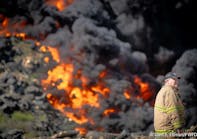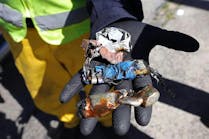What Happens When a Blanket of Insulation Conceals Overloaded Wiring?
In a recent two-week period, the Syracuse, NY, Fire Department had five fires involving blown-in cellulose insulation. It surely is a case where homeowners trying to save money ended up spending more in the long run. What's going on?
Cellulose is "green." This insulation is 80% post-consumer recycled newsprint. Most often, it is chemically treated with non-toxic borate compounds to resist fire, insects, rodents and mold. For those whose homes were built in the 1950s and who are looking to increase the R-value of their homes' insulation blanket, it appeared that adding blown-in cellulose is just the ticket. (According to the U.S. Department of Energy/Oak Ridge National Laboratory, "Insulation is rated in terms of thermal resistance, called R-value, which indicates the resistance to heat flow. The higher the R-value, the greater the insulating effectiveness. The R-value of thermal insulation depends on the type of material, its thickness, and its density." See http://www.ornl.gov/sci/roofs+walls/insulation/ins_02.html.)
So why all the fuss? In total, we have had seven incidents involving blown-in cellulose insulation within two months. In defense of the product, I will admit that it was not the cause of the problem, but it definitely was a contributing factor. In all cases, the homes were at least 50 years old. The original insulation was fiberglass batting with paper backing. The wiring at each structure was the original cloth-covered non-metallic two-strand copper. And at each incident, blown-in cellulose insulation completely blanketed the attic space. This insulation was added many years after the home was constructed to help increase the insulation blanket.
Another common factor at the fires was the existence of the original 60-amp fuse box in the basement. With these old services, it was possible to circumvent the protection by screwing in a larger-amp fuse. Back then, the fuses (known as Edison base) were interchangeable. The newer safety fuses have different threads for each amperage. Higher amp fuses cannot be screwed into a lower amp circuit.
Recipe for Disaster
Overloading of electrical circuits is the human element of the equation. Summer comes and occupants install a window air conditioner. Perhaps it's cold and they use an electric blanket. In the next room, junior has his computer work station with scanner, printer and monitor plugged into a wire strip. All of a sudden, the occupant sees that the fuses seem to blow more often. The inconvenience and cost of fuse replacement becomes bothersome. Well, with only four fuses to serve the entire house, that one fuse is probably covering two bedrooms and the bathroom. Perhaps (as in one of my incidents) the fuse covered three bedrooms and the basement. No wonder it kept blowing! So, the ill-advised human screws in a 20-amp fuse instead of the requisite 15-amp.
Now let's return to the concealed attic space above. For 45 years, that non-metallic wiring was exposed to the air. It was originally installed above the batt insulation and any heat generated by flowing electrical current dissipated readily into the attic air. The homeowner, needing to save energy, paid a contractor to blow in cellulose insulation over the entire attic space. To obtain the greatest R-value for the money, the homeowner gets 16 inches of the stuff. This, by the way, is exactly how every reference document describes proper installation.
The original wiring is now buried deep under the cellulose. There is no convective method for the wire to dissipate heat. Today's appliances and electronics create a greater electrical load. This large current draw heats up the electrical lines more often. And the icing on the proverbial cake is the installation of a fuse rated much higher than what the circuit was designed for. Voila! We have the perfect mix for an attic fire. The overheated wires burn down into the ceiling joists.
Tricks & Tips
Your initial dispatch will probably be something related to "an odor of something burning" or "electrical problem." As soon as you enter the structure, your nose will tell you that it is certainly class A combustibles burning. Check for that fuse box in the basement and ask the occupants whether they have been having problems with blown fuses. Finally, ask them if they know whether the house has blown-in cellulose insulation.
You may be able to access the attic or crawl space to confirm the presence of smoke. Your next move should be to grab a thermal imaging camera from the apparatus and rapidly scan the ceilings from below and the attic floor from above, if possible. Once you have located the hot spot, prepare the area below with fireproof tarpaulins. It is nearly impossible to remove the insulation except by pulling ceilings. The removal of the insulation is necessary to expose the wiring. In the name of customer service, show the occupants the image on the thermal imager before you pull the ceilings. They will be amazed at the live embers that fall once you begin to open up.
The handling of the cellulose is much cleaner if it is kept dry. It is considered to be a "nuisance dust" rather than a hazardous material. An ordinary dust mask is sufficient protection. Once you have exposed the burned ceiling joists and wiring, you only need a water can to extinguish the smoldering material. Hitting the cellulose-filled attic space with a handline will create a huge mess. The weight of the wet insulation will collapse all the Sheetrock onto the rooms below - not good customer relations.
Wait, There's More
Two of our fires involving cellulose insulation came back to life several hours after we left the scene. I admit it - my fire rekindled. Actually, it just started smoldering again. I am sure you know how compassionate all my fellow chiefs were at my poor extinguishment performance. I did, however, discover a dark secret that I am certain will raise the ire of many cellulose-insulation installers who read this column.
Back in the late 1970s, the U.S. Consumer Product Safety Commission conducted studies of samples of cellulose taken from homes. The surveys apparently found a high incidence of non-compliance with government and industry standards in regard to fire resistivity. At that time, it was claimed that there was widespread failure of the manufacturers to adequately treat the cellulose. More recently, the California Bureau of Home Furnishings conducted a similar survey. What has evolved is a not-so-friendly mudslinging relationship between the cellulose-insulation manufacturers and the fiberglass batt insulation manufacturers. I do have a personal opinion based on the age of the structure involved at my incident. I am willing to bet that it had one of those questionable batches of cellulose insulation!
My advice is simple. If you find yourself facing a smoldering fire involving blown-in cellulose insulation, slow down. It will be a long, drawn-out ordeal as you systematically remove Sheetrock ceilings, smoldering insulation and charred structural members. Remove insulation at least four feet on either side of the charred joists. Become proficient in the use a thermal imaging camera. This tool was helpful in pinpointing the smoldering ceiling joists from below. Encourage the occupants to stay in the residence after you take up. An activated smoke detector will not help if a "re-smoldering" occurs and the occupants are staying elsewhere.
I believe that fires involving cellulose insulation will continue to occur with frequency. The overloading and overheating of original wiring will be the cause. The insulation contributes by prohibiting the heat from dissipating, causing the wooden members to burn with limited oxygen supply. This is the textbook definition of pyrolosis. It is also known as "smoldering combustion."
MARK MCLEES, a Firehouse® contributing editor, is a district chief in the Syracuse, NY, Fire Department. He was on the development team for New York State's Firefighter Survival and Rapid Intervention courses. McLees has a bachelor of science degree in fire science from John Jay College of Criminal Justice/The City University of New York.





